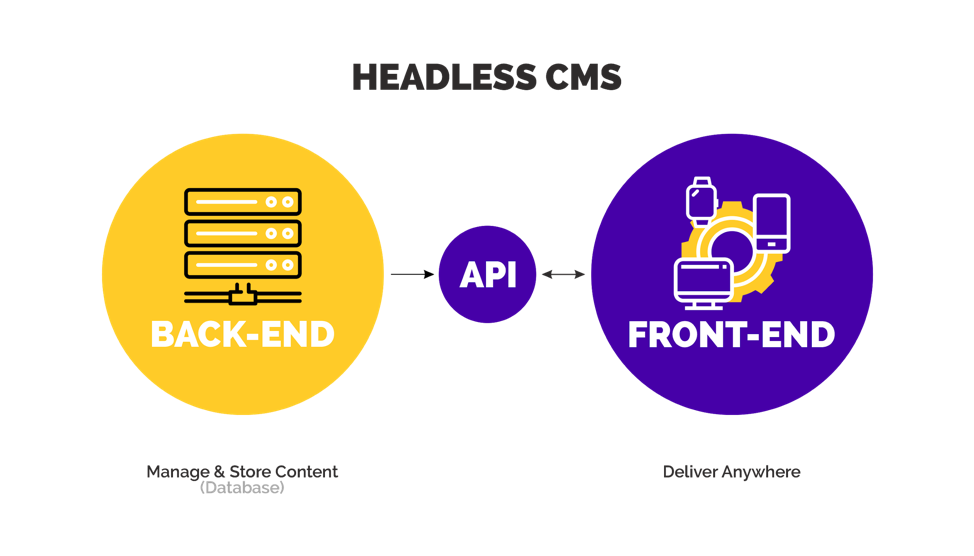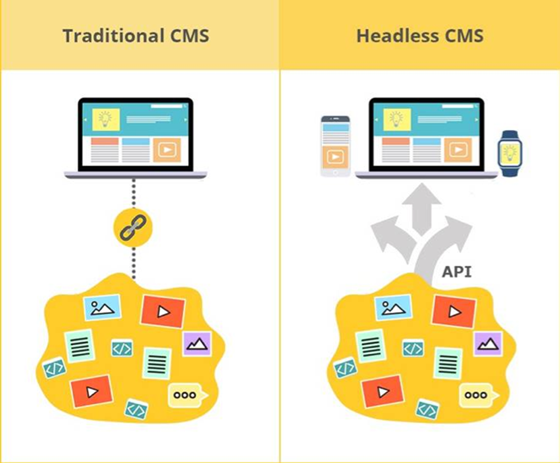API-based Architecture of Headless CMS: Benefits and Use Cases
The traditional Content Management Systems (CMS) have served us well since the advent of Web 2.0. However, as content marketing trends evolve, the disconnect between the Developer Experience and Editor Experience is more evident than ever. The need of the hour is for a type of CMS where the Content Managers or Editors only concern themselves about how well the content is managed and presented, while the CMS takes charge of how the content is delivered to users/subscribers across omnichannel touchpoints. How do you create such an efficient content management and delivery system?
With the help of a Headless CMS, of course. But, before we can stress how a Headless CMS with an API-based build benefits you more than a traditional CMS, we must first understand what is an API and how it augments the CMS experience.
What is an API?
Think of an API or an Application Programming Interface as a computing interface built with a specific task in mind. Developers can use an API to help their application interact with external services using a set of simple commands. In the past, developers strived to develop entire application modules from scratch to have the said application perform a specific task. An API speeds up that process by offering a readymade, modular programming interface that can be simply added to the software application to extend its features.
Therefore, in the context of a CMS, an API with its in-built methods and protocols, can help you facilitate a better content management strategy and experience. So, let us demystify what is a Headless CMS and how leverages its API-based structure.
What is a Headless CMS?
The traditional CMS route followed a very rigid cycle, where the platform would be built first, and then the content was poured in; this presented a challenge as content marketing trends and channels evolved. Any time an update was required the Content Editors and Managers would have to rely on developers to apply the changes. As the frontend and the backend was tightly bound, issues with the former would cause a downtime in the latter. Plus, there was the task of making the content platform responsively available across all marketing mediums.

A headless CMS can help overcome these challenges by decoupling the presentation layer of your content platform from the backend processes. If the presentation layer of your content can be referred to as the ‘head’, then the content repository can be considered the ‘body’. Therefore, a Headless CMS, contrary to a traditional CMS system, segregates the frontend or ‘head’ from the backend or ‘body’; ergo, a Headless CMS. An effective Headless Content Management System, helps you bridge the frontend to the backend with the help of an API-based architecture. In this way, you only have to focus on maintaining the content database and how the UX layout appears as the presentation layer; while, the API-architecture acting in between takes charge of delivering that content across various mediums.
Let us have a look at how the API-based architecture of a Headless CMS empowers your content platform.
What does the Headless CMS achieve with an API-based Architecture?
In a Headless CMS, the API-based architecture plays a big role in making the Content Managers job easier in the context of content page management and relationships; which grants them a lot of autonomy with regards to the frontend of the content platform. A Headless CMS will offer you a cloud-based backend platform so your content repository is easily accessible without any manual intervention on your part. You only need to add content to that repository, while you and your team handle the frontend layout, UX, etc. The rest is taken care of by a REST API.

As mentioned before, API acts as a bridge between your frontend and backend by decoupling them from each other. It grants you the flexibility to develop the front-end in any framework without having to factor the backend into the equation. So, you can use any modern scripting language you prefer, and harness the full power of the developmental framework, with a scalable, cloud-based backend for support, nonetheless. The icing on the cake- Once the content is ready, the Headless CMS and its APIs integrates the decoupled backend and frontend and serves the content platform to users/customers across any medium you target- be it a smart-phone, or a tablet, or even VR!
Thus, a Headless CMS offers you a number of benefits over a traditional CMS, across various use cases.
Use cases where Headless CMS merits over a traditional CMS
There are many end-to-end benefits of using an API-based Headless CMS. The following points summarize the use cases where a modern Headless CMS outshines a traditional CMS:
Progressive API-based architecture
API and SDKs help focus on Content Relationships and Page Management. The API renders the content and its UI written in any framework and compiles the same as JSON data so your subscribers on any platform enjoy a native UX. As everything is managed via API calls your platform can support innumerable users at once.
Thus, an API-based CMS aims to provide a ‘write once, display anywhere’ approach towards content management; this has been lacking in traditional CMSs that tightly coupled frontends to the backend logic. With the API regulating the decoupled frontend and backend and delivering it to the audience, the Headless CMS makes improving and scaling up the developmental aspects easier for you.
Better scope of development
A Headless CMS with an API-supported build offers a more stable content platform. For instance, Agility CMS processes API requests via a global CDN using Stackpath. You do not even need a full-stack developer to set-up the APIs; the APIs auto-resolve content dependencies so you do not have to manually set up every API call. Nifty right?
A Headless CMS does not follow the one-and-done process of the old, traditional CMSs. With a Headless CMS working under the hood, you get plenty of room to work on the frontend. A small, dedicated team for frontend development should suffice. Face-lifting the content platform design, adding new features, etc. have no impact on your content repository, further omitting the need for specialized development services.
Improved Omnichannel marketing
The content marketing industry is poised to only grow at this point. Studies reveal that at least 70% of marketers today are actively invested in content marketing, while 24% of them are already contemplating ramping up their investment in content marketing. The idea is to make your content available in a highly presentable format before your audience, across as many channels as possible.
Fleshing out such a service for all channels, on a traditional Content Management System (CMS) would be quite a laborious, costly, and time-consuming process. However, with the Headless ‘Content-first’ approach, you can take full advantage of your omnichannel content marketing strategy. Your marketing content is available on more mediums with lesser cost and effort than it would take on a traditional CMS.
Cost benefits:
Operations
50% of all content created for marketing is done with new customer conversion in mind. However, only about 17% of content platforms utilize the landing page; and there is an average loss of conversion rates by 4.42% for every extra second it takes a traditional CMS to load pages. Headless CMS uses API calls so that there is no lag in content loading. You can focus on utilizing the frontend and improving marketing strategies for better conversion rates.
Maintenance
Unlike a traditional CMS, in a Headless CMS, you do not have to worry about backend developmental services and costs. With a dedicated team customizing the API bridge between the frontend and backend, there are no added developmental costs. With a decoupled backend, there is no downtime for your website either. Instead, you can channel your time, efforts, and investment to leverage the code for embellishing the frontend.
Scalable and future-ready
Statistics show that 24% of marketers are already planning on increasing their investment in content marketing. With a Headless API-based CMS there is no expenditure in streamlining your content across each marketing channel. You can also easily produce new app-servers as per requirement, and let your cloud-based CMS worry about the hosting as you scale up your content platform.
In Conclusion
Traditional CMS’s have done well when it came to content publishing for a linear marketing channel, e.g., a desktop website. Making this content responsive to other platforms was the developer’s task.
Businesses Content Managers today, however, need the same content to be available at once to their entire demographic, simultaneously across all platforms, for omnichannel marketing.
A Headless CMS with an API-based architecture can offer platform-agnostic, ‘Headless’ content management- so you can improve content quality distribution and strategically target audience conversion across diverse marketing channels, with lesser effort, and at a lesser cost.

Joel Varty
Joel Varty is President of Agility CMS. Joel has over 20 years of experience in customer relationship management, product management and has embraced cloud technology as a groundbreaking concept over a decade ago. Joel is a frequent writer for Agility CMS blog and leads many webinars and trainings for developers and digital leaders.